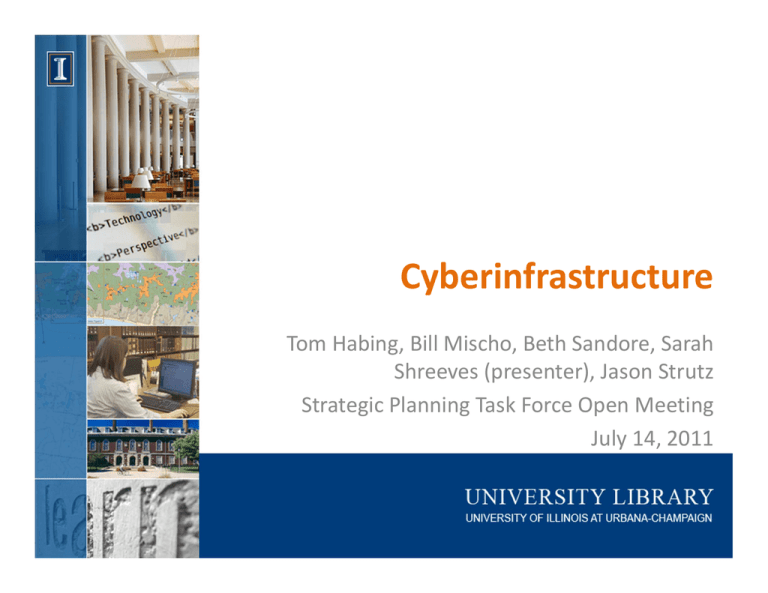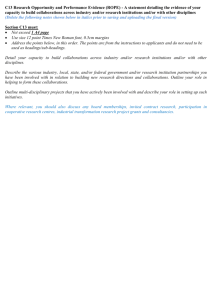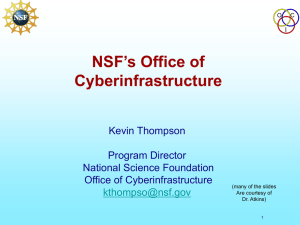Cyberinfrastructure
advertisement

Cyberinfrastructure Tom Habing, Bill Mischo, Beth Sandore, Sarah Shreeves (presenter), Jason Strutz Strategic Planning Task Force Open Meeting July 14, 2011 Definition The term "cyberinfrastructure" describes the new research environments that support advanced data acquisition, data storage, data management, data integration, data mining, data visualization and other computing and information processing services over the Internet. 2 Major Accomplishments • Implemented forward looking technical infrastructure within Library • Restructured IT to better support library services and research • Established IDEALS and Scholarly Commons to better support researcher needs • Awarded major grants supporting cyberinfrastructure (Ethics, Bamboo, IMLS DCC, ArchiveSpace) • Active participants in range of community infrastructure initiatives (DuraSpace, Hydra, Bamboo, Archon, BibApp, HubZero, DMP Online) 3 Impact • If we had not made the investment we’ve made in IT over last 5 years, library services and research would be stymied • We have greater stability and disaster recovery • We can accomplish more given our collaborations and participation in community initiatives • We are more systematic about applying research findings to your production services and systems 4 Opportunities • With major grants such as the NSF Ethics work, Bamboo, and ArchiveSpace, we continue to have opportunities to apply experience and knowledge garnered during research to our production environments • NSF Data Management Plan and upcoming Year of Data Stewardship are opportunities to solicit requirements for infrastructure and services • Data stewardship / Center for Media Excellence / Electronic Theses and Dissertations are all opportunities to position the library as the leader in providing best practices, services, infrastructure for digitial preservation, data management, and copyright. • Rich collections that could be better brought to our users and made available for mining, analysis, and use • We have an opportunity to leverage campus resources such as the data center consolidation to extend our technical infrastructure 5 Initiatives • Establish a robust, extensible storage infrastructure for management, preservation, access and use of digital files for use internally as well as externally (e.g. research datasets) – Include active file system, local preservation repository, and third party services (Hathi, DuraCloud) – Includes policies, workflows, and best practices for all content – Work with units on how to improve access and use of collections within infrastructure – Metrics: Size and number of files, downtime statistics, items preserved, ease of use • Develop and implement services to support emerging and advanced research needs of Illinois community – Data curation/management services and tools including best practices – Information manipulation tools and services: GIS, text mining and encoding, image manipulation and display, audio and video creation and editing – Support for using our collections in innovative ways – Scholarly Communication services: copyright consultation, open access and publishing – Metrics: Number of faculty, students, researchers served; collaborations formed with faculty and research centers on campus (eg I3), use of tools 6 Resources Needed • People: technical and functional specialists to support permanent infrastructure additions, outreach, and instructional efforts • Technology: Software and hardware to support both initiatives • Organizational: Training of internal staff to work with users; support for travel for collaborations/community initiatives; closer collaborations between IT and content /use specialists • Space: Better integrated space for advanced research services; better access to technology outside of Main Library 7 Impact • Position the Library for robust, reliable management, preservation, and access infrastructure for long into the future: better services, better preservation, better search and discovery, reliable and accessible content • Enable our collections to be used to their full potential • Library could become a campus leader in providing innovative, advanced research support to faculty, students, and researchers in a production and service oriented environment • Library would be well positioned for future collaborations (internal and external) and research projects – building a reputation as a leader in research and development among our peers 8 Task Force Questions and Discussion 9



